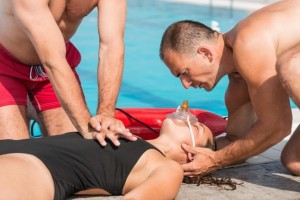Playing on the open water with bright sunshine, blue sky and a gentle breeze. That’s summer in southern Ontario. Teens out on the lake in a blowup just being teen boys. In light of the local drowning of a 14-year-old in Lake Ontario this week, I felt we could use a gentle reminder.
Open water activities such as swimming, boating, and kayaking are popular recreational pastimes for many people. However, it is crucial to understand the potential dangers and always prioritize safety. When is the best time to wear a PFD? One of the most significant dangers of being in open water without a Personal Floatation Device (PFD) is the increased risk of drowning. In this blog, we will explore the dangers associated with being in open water without a PFD and highlight the importance of wearing one to ensure your safety.
Understanding the Risks
- Submerged Hazards: Open water bodies, such as lakes, rivers, and oceans, can be unpredictable and may hide dangerous submerged hazards beneath the surface. Without a PFD, the risk of accidental submersion and potential drowning increases significantly.
- Fatigue and Cramps: In open water, swimming or treading water can be physically demanding. Even the strongest swimmers can become fatigued over time. In the absence of a PFD, the risk of fatigue-induced muscle cramps or exhaustion may lead to a person being unable to stay afloat, thereby increasing the risk of drowning.
- Unpredictable Weather and Water Conditions: Weather conditions can change rapidly, and water conditions can become hazardous without warning. Strong currents, swift tides, and unexpected storms can make it difficult to stay above water without the assistance of a PFD.
- Unforeseen Accidents: Accidents can happen at any time, even to experienced swimmers or boaters. Slippery surfaces, collisions, or sudden medical emergencies can compromise a person’s ability to swim and stay above water. A PFD provides a valuable safety net in such circumstances.
The Importance of Personal Floatation Devices (PFDs)
- Buoyancy and Stability: PFDs are designed to provide buoyancy to keep a person afloat. By distributing the body’s weight and allowing for easier breathing, a PFD helps conserve energy while keeping the head and airway above the water’s surface.
- Increased Visibility: PFDs are typically brightly colored and often have reflective material, making it easier for rescuers to spot individuals in distress. This increased visibility can be critical during rescue operations, especially in large bodies of water.
- Assistance in Cold Water: Immersion in cold water can quickly lead to hypothermia, impairing a person’s ability to swim or make rational decisions. PFDs offer additional insulation, helping to maintain body heat in cold water and increasing the chances of survival until rescue arrives.
- Peace of Mind: Wearing a PFD provides peace of mind, allowing individuals to focus on enjoying their time in the water without the constant worry of potential accidents. This confidence in personal safety can enhance the overall experience and make aquatic activities more enjoyable for everyone involved.
PFD Guidelines and Recommendations
- Proper Fit: Ensure that your PFD fits snugly and comfortably. It should not be too loose, as this can impede its effectiveness, nor too tight to restrict movement or breathing.
- Type and Quality: Select a PFD appropriate for your activity, such as a life jacket, inflatable PFD, or foam PFD. Check that your PFD meets the necessary safety standards and is in good condition.
- Wear It at All Times: Wear your PFD whenever you are engaged in open water activities, regardless of your swimming abilities or proximity to the shore. Accidents can occur unexpectedly, and wearing a PFD offers the best protection against drowning.
- Lead by Example: Encourage others to wear their PFDs and follow proper safety protocols. By setting a good example, you contribute to creating a culture of safety and spreading awareness about the importance of PFD usage.
Conclusion
Being in open water without a personal floatation device (PFD) poses significant risks, primarily related to drowning and other water-related accidents. We cannot emphasize enough how crucial it is to prioritize safety by wearing a PFD whenever engaging in aquatic activities. By understanding the risks, adhering to safety guidelines, and taking the simple precaution of wearing a PFD, you can greatly enhance your chances of staying safe and enjoying your time in open water. Let’s make safety a priority and create a culture of aquatic recreation that is both enjoyable and free from unnecessary risks.


1 Comments